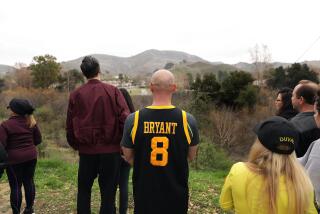Crash Delays Dream
LONDON — Wanted: Grandmother seeks Bell 407 helicopter, preferably cherry red, and the money to insure and fly it up the whole length of the Americas to the North Pole.
Jennifer Murray and fellow British pilot Colin Bodill nearly lost their lives when they crashed in Antarctica before Christmas. Their record hopes crashed with them, but they have not lost their ambition to fly a helicopter from pole to pole.
“We can’t start again from where we unfortunately left off because it is winter there now. But for all sorts of reasons, we both want to get back in the air as soon as we can and resume the journey from as far south as we can,” she said.
“We need to get back in the air within four or five weeks because if we wait any longer, it gets far more dangerous going for the North Pole. We also have the momentum now and may lose it if we start all over again next season.”
Murray, 63, and Bodill, 53, made it to the South Pole in mid-December after setting off from New York on Oct. 22 and flying down the east coast of the Americas.
But on their way back north, 11,000 miles into their 33,000-mile trip, they flew into a whiteout -- when snow and sky become indistinguishable -- and crashed on the middle of the coldest, loneliest continent on Earth.
“We didn’t actually fall. We actually flew into the ground. I suppose the luckiest part was that the helicopter somersaulted and took most of the impact,” Murray said in an interview in her London home six weeks after the crash.
The impact turned the seven-seater Bell chopper into a pile of junk and gave Bodill internal injuries and snapped a bone in his back. Murray suffered only a dislocated left elbow.
“We are incredibly lucky to be alive,” she said, massaging her arm. “Colin saved my life. I just sat there fading in and out of consciousness while he did everything. He is my hero.”
Although bleeding internally, Bodill, a flying instructor, built a tent and kept in radio contact with Patriot Hills -- an Antarctic base that caters mainly to summer tourists -- awaiting emergency evacuation.
“We lay on the ice for 4 1/2 hours. At one stage, he said to me, ‘I am fading.’ Then I thought he had died. But he got us both through. I can remember the cold, the intense cold,” Murray said.
Neither pilot was wearing full Antarctic gear, which was stowed in the back of the crumpled helicopter and irretrievable.
“I had been wearing my snow boots, which were wonderfully warm. One of them got thrown 30 meters [yards] from the crash. Colin went to get it expecting to find my foot inside. Luckily it wasn’t,” Murray said.
One of the things that kept her going, she has said, was thinking about her 6-year-old granddaughter. “There was a great deal of trauma involved. I still wake up at nights and it is all happening all over again,” she said. “But it was a great project and I want to complete it.”
The pair were rescued, evacuated, and are both recovering and raring to go. The original attempt had corporate sponsorship, but they would need fresh money to continue.
Murray shares a taste for adventure with her husband, Simon, a French foreign legionnaire turned businessman who, at 63, has just become the oldest man to walk to the South Pole.
More to Read
Sign up for Essential California
The most important California stories and recommendations in your inbox every morning.
You may occasionally receive promotional content from the Los Angeles Times.








